Real World DirectX 10 Performance: It Ain't Pretty
by Derek Wilson on July 5, 2007 9:00 AM EST- Posted in
- GPUs
DirectX 9 vs. DirectX 10
Here we'll take a closer look at some of the scaling differences between DirectX 9 and DirectX 10 on current hardware under current drivers with Company of Heroes and Lost Planet.
First up is a look at relative scaling between cards under each API. The idea is to see whether cards that perform better under DX9 also perform better under DX10 (and vice versa). This will only give us a glimpse at what could happen going forward, as every game (and every implementation of that game) will be different.
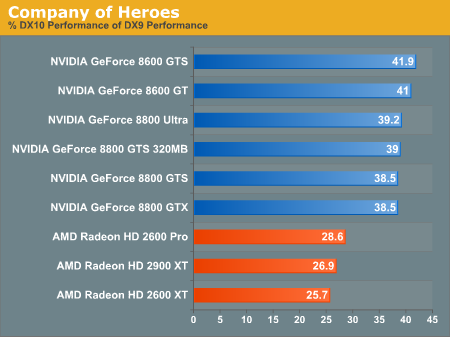
For Company of Heroes, we see huge performance drops in moving to DirectX 10 from DirectX 9. The new lighting and shadowing techniques combined with liberal geometry shader use are responsible for at least halving performance when running the more detailed DX10 path. NVIDIA seems to handle the new features Relic added better than AMD. These results are especially impressive remembering that NVIDIA already outperformed AMD hardware under DX9.
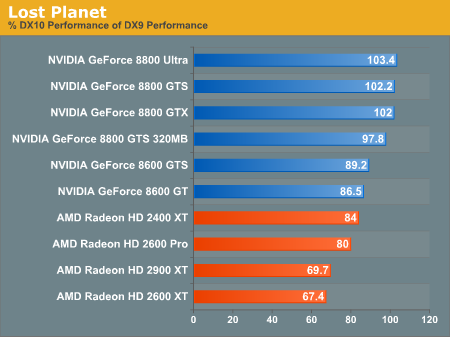
Lost Planet is a completely different animal. With Capcom going for a performance boost under DX10, we can see that they actually succeeded with the top of the line NVIDIA cards. There isn't much else enticing about the DX10 version of Lost planet, and it's clear that AMD's drivers haven't been optimized to tackle this game quite yet.
Next we want to take a look at AA scaling difference between DirectX 9 and DirectX 10. Can we expect less impact from AA on one API or the other? Let's take a look.
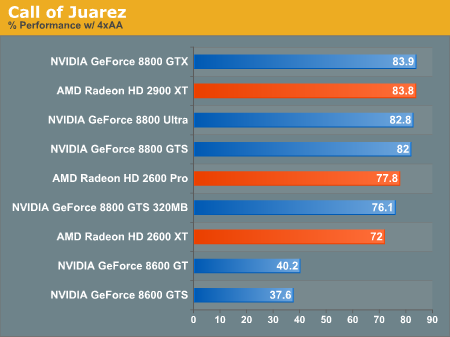
Under Call of Juarez, our low-end NVIDIA cards suffer from a huge drop in performance when AA is enabled. This is likely due to the fact that they can't handle either the bandwidth or the shader requirements of Techland's HDR correct AA. The higher end parts seem to handle the AA method fairly well, though certainly NVIDIA would be happier if the retained their hardware AA advantage.
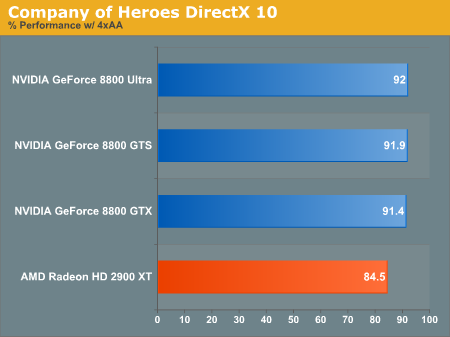
For our DX10 Company of Heroes test, which does use hardware MSAA resolve where available, AMD hardware scales much worse than NVIDIA hardware.
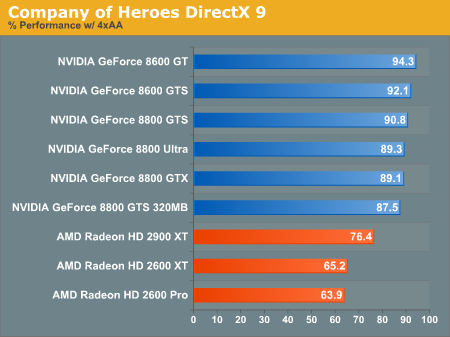
All of our cards scale worse under DX9 when enabling 4xAA than under DX10. While we don't have enough information to really understand why that is under Company of Heroes, it is certainly interesting to see some sort of across the board performance advantage for DX10 (even if it is in a round about way).

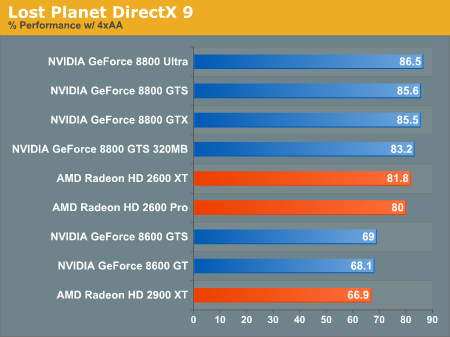
Lost Planet, with its attempt to improve performance by moving to DX10, delivers very similar performance impact from AA in either DX9 or DX10. Again we see a very slight scaling advantage in favor of DX10 (especially with AMD hardware), but nothing life changing.
Here we'll take a closer look at some of the scaling differences between DirectX 9 and DirectX 10 on current hardware under current drivers with Company of Heroes and Lost Planet.
First up is a look at relative scaling between cards under each API. The idea is to see whether cards that perform better under DX9 also perform better under DX10 (and vice versa). This will only give us a glimpse at what could happen going forward, as every game (and every implementation of that game) will be different.

For Company of Heroes, we see huge performance drops in moving to DirectX 10 from DirectX 9. The new lighting and shadowing techniques combined with liberal geometry shader use are responsible for at least halving performance when running the more detailed DX10 path. NVIDIA seems to handle the new features Relic added better than AMD. These results are especially impressive remembering that NVIDIA already outperformed AMD hardware under DX9.

Lost Planet is a completely different animal. With Capcom going for a performance boost under DX10, we can see that they actually succeeded with the top of the line NVIDIA cards. There isn't much else enticing about the DX10 version of Lost planet, and it's clear that AMD's drivers haven't been optimized to tackle this game quite yet.
Next we want to take a look at AA scaling difference between DirectX 9 and DirectX 10. Can we expect less impact from AA on one API or the other? Let's take a look.

Under Call of Juarez, our low-end NVIDIA cards suffer from a huge drop in performance when AA is enabled. This is likely due to the fact that they can't handle either the bandwidth or the shader requirements of Techland's HDR correct AA. The higher end parts seem to handle the AA method fairly well, though certainly NVIDIA would be happier if the retained their hardware AA advantage.

For our DX10 Company of Heroes test, which does use hardware MSAA resolve where available, AMD hardware scales much worse than NVIDIA hardware.

All of our cards scale worse under DX9 when enabling 4xAA than under DX10. While we don't have enough information to really understand why that is under Company of Heroes, it is certainly interesting to see some sort of across the board performance advantage for DX10 (even if it is in a round about way).


Lost Planet, with its attempt to improve performance by moving to DX10, delivers very similar performance impact from AA in either DX9 or DX10. Again we see a very slight scaling advantage in favor of DX10 (especially with AMD hardware), but nothing life changing.










59 Comments
View All Comments
titan7 - Wednesday, July 11, 2007 - link
CoH also got 59.9fps on the GTX Ultra. Today's d3d10 games can run at full frame rates on today's hardware. Just ensure you're using the latest drivers and you have the most expensive card money can buy ;)BigDDesign - Thursday, July 5, 2007 - link
I'm with Derek here. I liked your article. We need much more powerful hardware and time for DX10, Drivers, Developers & Vista to get it together. A couple of years from now, all should be good with DX10. Not any sooner methinks.WaltC - Thursday, July 5, 2007 - link
This article, I thought, was extremely poor for several reasons:(1) DX10 in terms of developer support presently is just about exactly where DX9 was when Microsoft first released it. At the time, people were swearing up & down that DX8.1 was "great" and wondering what all of the fuss about DX9 really meant. Then we saw the protracted "shader model wars" in which nVidia kept defending pre-SM2.0 modes while ATi's 9700 Pro pushed nVidia all the way back to the drawing boards, as its SM2.0 support, specific to DX9, created both image quality and performance that it took nVidia a couple of years to catch.
AnandTech did indeed mention almost in passing that DX10 was still early yet, and that much would undoubtedly improve dramatically in the coming months, but I think that unfortunately AT created the impression that DX10 and DX9 were exactly *alike* except for the fact that DX10 framerates were about half as fast on average as DX9 framerates. A cardinal sin of omission, no doubt about it, because...
(2) DX10 is primarily if not exclusively about improvements in Image Quality. It is *not* about maintaining DX9-levels of IQ while outperforming DX9. It is about creating DX10 levels of Image Quality--period. AnandTech does not seem to understand this at all.
(3)First lesson in Image Quality analysis that even newbies can readily understand is this: if the performance is not where you want it, but the IQ is where you want it, then you do the following to improve performance *without* sacrificing Image Quality (This is a lesson that AnandTech truly seems to have completely forgotten):
Instead of talking about how sorry the performance was in DX10 titles (those very few early attempts that AT looked at), AT should have seen what AT could have done to increase performance while maintaining DX10-levels of Image Quality. That is, AT should have *lowered* test resolutions and raised the level of FSAA employed to get the best balance of Image quality and performance. AnandTech did not even try to do this--which in my view is inexcusable and fairly unforgivable. It is a very bad mistake. I'm sorry--but many, many people, including me, do not use 1280x1024 *exclusively* while playing 3d games. My DX9 resolution of choice is 1152x864, for instance.
The point to be made about DX10 is *not* frame rates locked in at 1280x1024. Sorry AT--you really screwed the pooch on this one. The whole point of DX10 is *better image quality* which everyone who ever graduated from the 3d-school-of-hard-knocks is *supposed* to know!
So, just what does a bunch of *bar charts* detailing absolutely nothing except frame rates tell us about DX10? Not much, if anything at all. Gee, it does tell us that with the reduced image quality that DX9 is capable of providing contrasted with DX10, that DX9 runs faster in terms of frames per second on DX10 hardware! Gosh, who might ever have guessed....<sarcasm>
IMO, the fact that DX10 software even early on is running slower than DX9 on DX10-compliant hardware tells *me* nothing except that DX10 is demanding a lot more work out of the hardware than DX9, which means that we can expect the Image Quality of DX10 to be much better than DX9. These early games that AT tested with are merely the tip of the iceburg of what is to come. AnandTech really blew this one.
Jeff7181 - Tuesday, September 11, 2007 - link
"DX10 is *not* frame rates locked in at 1280x1024"Too bad you didn't say this earlier in your rant, I could have saved myself a few minutes and stopped reading sooner.
Thanks for the laugh though... imagine... someone who thinks 1280x1024 is a frame rate telling AnandTech they screwed the pooch when publishing this article. LOL
titan7 - Thursday, July 12, 2007 - link
This article was awesome. Too bad reality doesn't match your expectations or you'd like it too.1) You have no idea what the "shader war" was about. There isn't even a single parallel to be drawn if you *correctly* look back.
2) d3d10 is nothing about image quality. No hardware on the market or rumoured to be coming out next generation can handle running a full length SM2.0b shaders! And forget about even 3.0! Or even 2.0a that the GeForceFX supported for that matter. d3d10 is about one thing-making d3d on the PC more like a console. That means lower CPU (not GPU!) overhead (more performance in CPU limited situations) and making lives easier for developers.
3) AT has CoH at 1024x768, 1280x1024, 1600x1200, and 1920x1200 (common native LCD resolutions). These days everybody has bigger monitors and playing below 1024x768 is pretty rare. You can extrapolate your 1152x864 resolution from that.
What this shows us is if you increase the image quality (see the screen shots) today's cards don't have enough power to run at full frame rate, with the exception of the 8800 GTX Ultra. AT did a great job showing the world that with simple bar graphs and everything. It's too bad you were too angry to realize that is all it was trying to show.
strikeback03 - Friday, July 6, 2007 - link
umm, they tested Company of Heroes and Call of Juarez at 1024x768, and Lost Planet at 800x600, and some of the cheaper cards could still not maintain playable frame rates. How low on the resolution do you want them to go?jay401 - Friday, July 6, 2007 - link
I'm not sure how raising FSAA is going to improve performance?Nor how removing DX10 visuals but lowering screen res will "maintain DX10 level of visuals" either?
anandtech02148 - Thursday, July 5, 2007 - link
Excellent sincere analysis of the current hardwares situation. Which lead me to some after thoughts,- Maybe a 600buxs PS3 isn't so bad after all.
-What am i going to do with this 8800gtx and the lack of pc games, quite dry season compare to consoles.
-For those of you who hold out longer than I have, a 8800gts or 2900xt is a decent investment if you have a 1920x1200 monitor to go with it.
kilkennycat - Thursday, July 5, 2007 - link
... if you presently have a DX9 system with acceptable performance. Until the NEXT generation of DX10 hardware is released.Anybody who goes out and buys a current Dx10 card ( or even worse, dual cards ) just because "the Dx10 games are coming" ( and "I want bragging-rights") has a lot more money than sense. Buying a 8600 or 2600 for acceptable HD-decoding in your HTPC (or your mid-range PC with a weak CPU) is the only purchasing action with the current Dx10 offerings that makes total sense. All of the upcoming Dx10-capable game-titles for 2007 will have excellent Dx9/SM3 graphics. The lack of Dx10 hardware will smother "bragging-rights" but will have zero effect on playability.
nVidia has been developing the successor family to the G80-series GPU for almost a year now and the first graphics cards from this new generation are expected by the end of 2007. I would not be at all surprised if the first card out of the chute in the new family will immediately fill the cost-space between 8600GTX and 8800GTS, but with DX9 and Dx10 performance far superior to the 8800GTS. No doubt the GPU will also be 65nm, since the manufacturing/yield cost of the huge 80nm G80 die is the immovable stumbling-block to dropping the price of the 8800GTS.
KeithTalent - Thursday, July 5, 2007 - link
That's fine if you game at resolutions below 1680x1050, but some of us game at higher resolutions, and most high-end DX9 cards were struggling mightily to play the latest DX9 games (Oblivion, Supreme Commander, STALKER, etc...).These new generation cards are not only about DX10, they are also about improved performance (exponentially improved performance actually) over that last generation, and some of us actually need that power.
What you said is all well and good for you if you are still gaming at 800x600 or whatever, but I like my resolution a little higher thank you very much.
KT